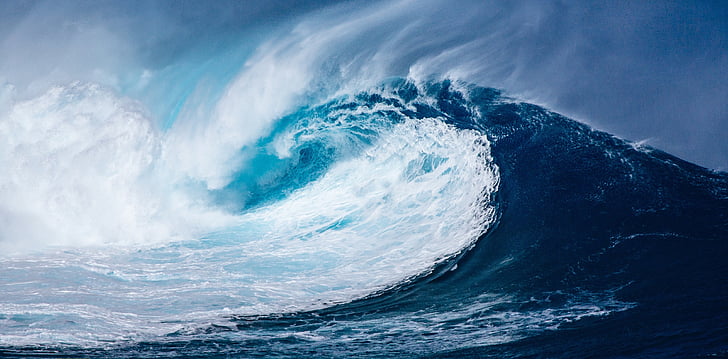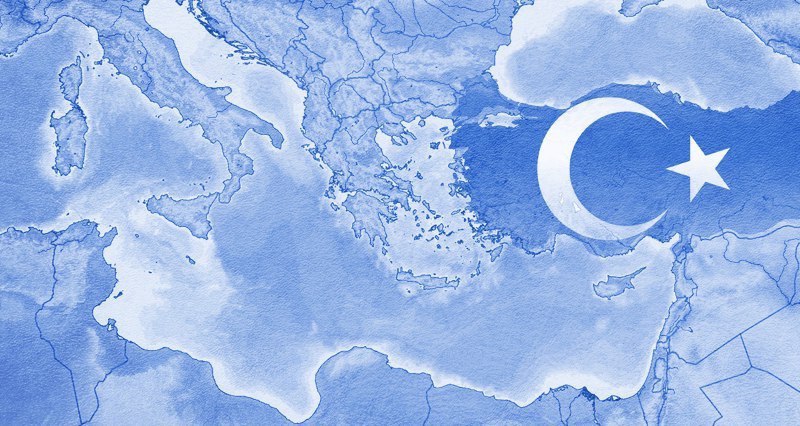Our ancestors who chose Anatolia, a land surrounded by seas, for their homeland rewarded future generations in doing so. Despite that the Ottomans had established an empire stretching over three continents with corresponding requirements of its political geography, they could not grasp the status of a maritime power even in a theoretical sense, with the exception of the 16th century. Thus, not only did it geopolitically drift further from the seas, it also could not achieve maritimization. The Ottoman’s lag in maritimization was as much due to inability to catch up with scientific and technological advancements abroad as it was capitulations to other maritime powers at the Ottoman Empire’s zenith. Those who imposed these capitulations on us have since navigated the oceans and grew richer as they attained new colonies, preventing other players from emerging into this new competitive realm.
They did everything to prevent Turks from sailing and gaining strength at sea. Our maritime history is full of burgeoning raids of maritime states such as in Çeşme, Navarin and Sinop. Unfortunately, the majority of these states are our allies today. A similar raid was carried out by FETÖ between 2008-2016.
THE HOMELAND SUFFERS FROM ITS LACK OF A NAVY
The decline at sea and lack of naval power coupled with the empire’s stagnation and fall culminated in loss of land and life and finally the invasion of Anatolia that, for the first time in history, threatened to leave Turks without a homeland. The War of Independence led by Mustafa Kemal Atatürk saved the Turkish nation, who would otherwise have been forced to become shepherds in the red-hot deserts under the Treaty of Sévres. In fact, the map of Sévres, which was torn and thrown away by the Lausanne Peace Treaty – the 97th anniversary of which we celebrate today – was a reflection of imperialism’s vision for Turks since the 18th century. The establishment of Greece, the loss of Cyprus in 1878 and the Aegean Islands after the Balkan Wars, and the cessation of the 12 Islands (Dodecanese) to Greece after the Second World War were all aimed at driving Turkey further away from the sea.
The map of Sévres cut off Turkey from open seas and oceans, surrounded by adversaries on all sides, burying Turks in land, never to become a threat to Europe again. Turkey responded to this map first with the War of Independence and the Treaty of Lausanne, then the Montreux Convention and the integration of Hatay (Antioch) to Anatolia. Nonetheless, imperialism reminded us that it would never give up after Atatürk’s death. Today, we still live with the stubborn consistency of imperialism which levels all kinds of incitements and threats from Syria to Libya, Iraq to Azerbaijan, the Black Sea to the Aegean, and the Eastern Mediterranean.
NATO AND IMPERIALISM
Turkey’s position in the Euro-Atlantic bloc after 1946 and NATO membership after 1952 subdued Anatolian geopolitics to the imperialist order. Turkey, with its cheap and abundant land soldiers would be a good tool to force Soviet divisions; if necessary, it would carry out the tasks assigned to it by Washington, especially with nuclear weapons. Turkey’s duty at sea had been limited to the Black Sea. Imperialism does not tolerate players who might become rival powers in the seas and oceans in the future. The Turkish navy had to stay as a coastal force. This situation suited the interests of the army’s elite top brass amongst us. For example, as NATO responsibility areas were designated in surrounding seas, we foolishly deferred the Aegean and the Eastern Mediterranean to Greece. Had the Cyprus crisis of 1963 had not broken out, Turkish governors fascinated by the NATO’s sparkle would not even dare to run naval drills in the Aegean and the Mediterranean. Turkish navy awakened with the Bloody Christmas in Cyprus in 1963 and 11 years later, on July 20, 1974, Turkey won its second victory after the War of Independence against imperialism. On that, Turkey put an end to imperialism’s encirclement campaign from its south. At this point, guarding vital rights and interests in the Aegean and the Mediterranean became the highest priority for the navy.
TOWARDS HIGH SEAS
As years passed by, especially in the post-Cold War period, Turkey achieved many successes in naval development and became worthy of mentioning amongst marine civilizations of the highest order. This period triggered naval advancement in every direction with the motto “Towards the High Seas”. This trajectory made a quantum leap through the effective use of the republican navy’s gunboat diplomacy in the Aegean and the Mediterranean and naval diplomacy in the Black Sea. The navy’s permanent mission in the Indian Ocean since 2009 accelerated this process. The construction of the home-design TCG Heybeliada corvette in 2011 at the Istanbul Shipyard with 70% national contribution ratio was a remarkable achievement along this successful trajectory. Unfortunately, the prize for these achievements was met by fictitious lawsuits such as Ergenekon, Kafes, Poyrazköy, Balyoz (Sledgehammer) and Military Espionage before the eyes of the government, parliament, the opposition, and the high command. The Turkish navy had to fall in line: 40 admirals and 400 sailors of the nation’s proud navy, who are as precious as their ships, were purged with false evidence and slander and imprisoned. This darkest period of Turkish maritime history came at the end after 2014. After FETÖ’s failed coup attempt of July 15, 2016, there was a profound shift in Turkey’s mechanism to guard its national defense and geopolitical interests. In this change process, the struggle to equitably share maritime jurisdiction zones and energy rights in the Eastern Mediterranean played a major role.
The process unfolded around the concept of the “Blue Homeland” following my terminology from 2006. The Turkish people loved this concept. Their interest in the navy rose exponentially. The process accelerated with the navy’s achievements in the Aegean and the Mediterranean, despite suffering through caliper lawsuits and its critical role in development of the indigenous national defense industry. This momentum has increased in an environment shaped by geopolitical maritime conflict, under conditions enabled by the rapid spread of information. The Blue Homeland has become a concrete symbol of this interest.

WHAT IS THE BLUE HOMELAND?
The Blue Homeland is a concept, a symbol, and also a doctrine.
As a concept, its scope consists of all maritime jurisdiction zones (inland waters, territorial waters, continental shelf, exclusive economic zone), declared or undeclared, as well as rivers and lakes. The Blue Homeland, in an exact sense, is an extension at sea and seabed of our homeland located between 26-45 East longitudes and 36-42 North latitudes. The Blue Homeland is the name of our zone of interest and jurisdiction over salty and fresh waters located between 25-45 East longitudes and 33-43 North latitudes.
As a symbol, it designates Turkey’s maritimization as its grand strategic goal for the state and its people in the 21st century. It symbolizes redirection of land-based mentality in Turkey to seas and thereby to achieve maritimization of its people.
As a doctrine, it’s a roadmap aimed to protect rights and interests in the seas surrounding Anatolia as well as seas and oceans beyond its periphery. Thereby, with their unique features, maritime principles and thoughts would be transformed into an illuminating roadmap and define our future on the axis of geopolitical zones of influence and defense. This concept could present new opportunities within the global process at a time of transition from unipolarity to multipolarity, from Atlantic age to Asian age, to strengthen Turkey’s geopolitical control over the Eastern Mediterranean, the Black Sea, and the Straits. It may open unprecedented windows for change in Turkey’s dossier of global, continental, and regional relations. Naturally, this doctrine necessitates Turkey’s legitimacy with international law to dominate maritime zones as well as capabilities and volition to trigger events over political, diplomatic, military, and economic dimensions.
THE BLUE HOMELAND IS ABOVE POLITICS
The Blue Homeland defends independent foreign and security policy and offers a defensive realist framework against the aggressive realist policies of the EU and the US. It keeps distance towards permanent alliances and blocs. Nonetheless, it is open to conjunctural temporary alliances and cooperation for the protection of our maritime rights and interests based on the principle that “states do not have permanent enemies and friends, they have interests”. It is based on the establishment and maintenance of internal and external peace in the line of Atatürk. It is environmentally friendly. It therefore adheres to the fact that sea-ocean ecology is the main determinant of the natural cycle on the planet. In disputed zones, it advocates fair and equitable sharing, which derives its power from international law, rights and merit. However, it rejects any and all maximalist maps, such as the Seville Map.
THE BLUE HOMELAND REFUSES THE SÉVRES AT SEA
The Blue Homeland is a paradigm that must be applied to whichever government rules in Turkey. It is actually the fruition of a process that started with Mustafa Kemal Atatürk. The first step of this process was Atatürk’s reclaim of full sovereignty over the Turkish Straits with the Montreux Convention. The management of Cyprus Peace Operation, Aegean Continental Shelf, Territorial Waters and Kardak crises in 1974 are successful stages in its implementation. On the other hand, there is a burning reality facing us today. Imperialism attempts to steal in the Aegean and the Eastern Mediterranean through Greek Cypriots and Greece an area of roughly 200 thousand square km (50 thousand square km Aegean, 150 thousand square km Mediterranean) from the Blue Homeland. For this reason, we define the process in question as the Second Sévres. In this process, it is essential to define the threat and raise geopolitical awareness. An area of roughly 462,000 square km constituted by our maritime jurisdiction zones not only offers us a potential to create economic wealth, but also provides a deep defense buffer and geopolitical maneuverability for our state to defend itself, first and foremost, from the sea. It should not be forgotten that the concept of Blue Homeland is the equivalent of our National Accord at sea in a conjecture that we face today in the Aegean and the Eastern Mediterranean.
The Blue Homeland is the second front of the directive “Your First Goal is the Mediterranean” that the Atatürk issued to his armies on the morning of September 1, 1922. It is a re-definition of Turkey’s homeland concept in the 21st century under its inevitable maritimization and geographical extension of our sovereignty at sea.
BREAKING THE SECOND SÉVRES VIA THE BLUE HOMELAND
The Turkish nation, which succeeded in gaining independence within a short time frame motivated by protecting its homeland and eliminating the impositions of Sévres from the ruins of an empire that was defeated and occupied in the 1920s, must defeat the occupation attempts against the Blue Homeland in the Aegean and the Eastern Mediterranean in the 21st century. This can only be achieved with a supra-national consensus above all political parties. Today, the Blue Homeland is ready as a doctrine. Nonetheless, it should be concluded with capable support of the government, opposition, and parliament in sub-strategic fields of military, diplomacy, and economy based on a long-term policy document. The Blue Homeland doctrine should be implemented not by daily decisions, but with an institutional guide having the authority of a national security policy document. The second scourge of Sévres we face at sea 100 years later can only be torn down by social consensus, unity, and solidarity.

















Leave a Reply